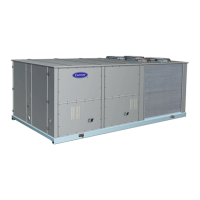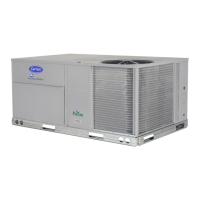20
to remove dirt and other contaminants from the gasket on the
sensor’s cover.
3. Squeeze the retainer clips on both sides of the optic housing
then lift the housing away from the printed circuit board.
4. Gently remove dirt and debris from around the optic plate and
inside the optic housing.
5. Replace the optic housing and sensor cover.
6. Connect power to the duct detector then perform a sensor
alarm test.
Fig. 28 — Sensor Cleaning Diagram
Indicators
NORMAL STATE
The smoke detector operates in the normal state in the absence of
any trouble conditions and when its sensing chamber is free of
smoke. In the normal state, the Power LED on both the sensor and
the controller are on and all other LEDs are off.
ALARM STATE
The smoke detector enters the alarm state when the amount of
smoke particulate in the sensor’s sensing chamber exceeds the
alarm threshold value. (See Table 3.)
Upon entering the alarm state:
• The sensor’s Alarm LED and the controller’s Alarm LED
turn on.
• The contacts on the controller’s two auxiliary relays switch
positions.
• The contacts on the controller’s alarm initiation relay
close.
• The controller’s remote alarm LED output is activated
(turned on).
• The controller’s high impedance multiple fan shutdown
control line is pulled to ground Trouble state.
The SuperDuct duct smoke detector enters the trouble state under
the following conditions:
• A sensor’s cover is removed and 20 minutes pass before it
is properly secured.
• A sensor’s environmental compensation limit is reached
(100% dirty).
• A wiring fault between a sensor and the controller is detected.
An internal sensor fault is detected upon entering the trouble state:
• The contacts on the controller’s supervisory relay switch
positions. (See Fig. 29.)
• If there is a sensor fault, the sensor’s trouble LED and the
controller trouble LED will turn on.
• If 100% dirty, the sensor’s Dirty LED turns on and the
controller’s Trouble LED flashes continuously.
• If a wiring fault between a sensor and the controller, the
controller’s Trouble LED turns on but not the sensor’s.
NOTE: All troubles are latched by the duct smoke detector. The
trouble condition must be cleared and then the duct smoke detec-
tor must be reset in order to restore it to the normal state.
Fig. 29 — Controller Assembly
HVAC DUCT
SAMPLING
TUBE
RETAINER
CLIP
OPTIC
PLATE
OPTIC
HOUSING
SENSOR
HOUSING
AIRFLOW
ALARM
POWER
TEST/RESET
SWITCH
TROUBLE
RESET
ALARM
TROUBLE
POWER
Table 3 — Detector Indicators
CONTROL OR INDICATOR DESCRIPTION
Magnetic test/reset switch
Resets the sensor when it is in the alarm or trouble state. Activates or tests the sensor when it is in the
normal state.
Alarm LED Indicates the sensor is in the alarm state.
Trouble LED Indicates the sensor is in the trouble state.
Dirty LED
Indicates the amount of environmental compensation used by the sensor
(flashing continuously = 100%)
Power LED Indicates the sensor is energized.

